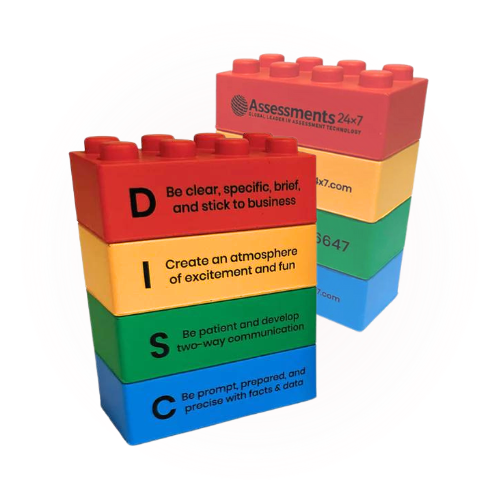
DISC BLOCKS SERVE AS...
Effective tools for style awareness, team building, stress relief, and communication enhancement. With their vibrant colors and versatility, DISC Blocks offer a practical and engaging way to enhance collaboration and understanding within groups and teams.
These blocks are four, soft Lego®-like pieces, each representing one of the DISC styles and a corresponding Adaptability phrase to immediately set the tone for interaction:
Why DISC BLOCKS?
By integrating DISC Blocks into the workplace, you can create a dynamic, engaging environment that not only highlights individual communication preferences but also promotes a deeper understanding of how these styles contribute to the collective success of the team's efforts
BENEFITS
IMPROVED TEAM DYNAMICS
By visualizing and acknowledging distinct communication styles, teams can better understand and leverage the diversity of perspectives, leading to improved collaboration and productivity.
CONFLICT REDUCTION
The use of DISC Blocks can help preempt misunderstandings and conflicts by providing a clear framework for interpreting team members' behaviors and responses.
CONTINUOUS LEARNING
Implementing DISC Blocks promotes an environment of continuous learning and development, as team members regularly assess and discuss communication styles, leading to ongoing improvements in team efficacy.
ENHANCED SELF-AWARENESS
DISC Blocks encourage individuals to reflect on their communication styles, fostering self-awareness and personal growth, which can lead to more effective interactions and leadership within the organization.
TAILORED APPROACH
DISC Blocks enable team members to adapt their communication strategies to suit different situations and audiences within the organization, allowing for more tailored and successful interactions.
APPLICATION
Building Communication & Understanding as a Team/Group

Small Group Practice | DISC Block Challenge: Effective Communication
In this activity, the team is divided into 4 small groups, with each given one DISC Block. Each group is presented with a message, and they must craft an effective way to communicate the message to their assigned DISC Block style. Each message is then shared with the group at large to gather feedback on if that message has been communicated appropriately, or if there should be something different in the communication. Discuss the implications of differing audiences, mindsets, the kind of message (modality), context and timing of the message, and what the intention is of the message compared to the perception of what may be received to ensure the message is effective. Then, switch style blocks, and repeat with a new message to practice adaptability and incorporate feedback from the first time through.
Small Group Practice | DISC Block Challenge: Scenarios
In this activity, the team is divided into small groups, with each member given a full set of DISC Blocks. Each group is presented with a series of hypothetical workplace scenarios requiring cooperation, leadership, negotiation, and adaptability. Members silently choose the DISC Block that they feel represents the best communication style to handle the situation. After revealing their choices, each group discusses the benefits and potential drawbacks of the collective styles represented. Through this engaging exercise, team members can gain a deeper understanding of how different communication styles can be effective in a variety of contexts, fostering a sense of empathy and strategic thinking within the team.
Workshop/Large group Practice | Fostering Participation & Understanding
- Ice Breaker Option 1: Introductions: Start the workshop by having each participant select a DISC Block that they feel currently represents their communication style. Ask them to share why they chose that block, encouraging a discussion about how different styles can positively impact a workshop setting.
- Ice Breaker Option 1: Observations: Start the workshop by having each participant introduce themselves and share their name, role, something they love about their work, and something they expect to learn about in the session. Ask each participant to choose the block that they think represents that person’s style, based on their observations of the short introduction.
- Group Activities: Divide participants into groups and give each group a scenario to work through using their complete set of DISC Blocks. Instruct them to clearly note which styles are being used for which part of the solution. For example, tackling a problem that requires a balance of assertiveness and careful planning might see both Red and Blue Blocks being used prominently.
- Role Swap: Challenge participants to swap blocks with someone demonstrating a different style and take on that style for an assigned time. This will encourage them to consider alternative perspectives and approaches, emphasizing adaptability and empathy in communication.
- Active Reflection: Throughout the workshop, integrate moments where participants reflect on the activities in the session or their use of the DISC Blocks and what insights they've gained. They can reflect in their own style, and then consider how another style would likely reflect on the same activity. They could share how using a different style affected their interaction in the group activity or their problem-solving approach.
- Debrief Session: Conclude the workshop with a debrief, encouraging participants to discuss how the use of DISC Blocks influenced the workshop dynamics and what they learned about other communication styles. Gather ideas of how they may plan to use the DISC Blocks and encourage them to teach someone else they know about the DISC styles using the blocks.
Zoom Meetings | Application in Virtual settings
To effectively use DISC Blocks in a virtual setting like a Zoom meeting, teams can follow these steps:
- Preparation: Prior to the meeting, ensure each team member has a set of DISC Blocks. In a remote work environment, this might mean mailing a set to each participant or using a digital representation if physical blocks are not an option.
- Introductions: At the start of the Zoom call, have each participant introduce themselves along with their chosen DISC Block for the meeting. Encourage team members to place their physical block or digital representation in view of the camera.
- Meeting Guidelines: Establish guidelines for using DISC Blocks during the meeting. For instance, if a team member wishes to display a change in their communication style, they would hold up a different color block to the camera.
- Active Use: Incorporate active block usage during discussions. For example, when brainstorming, a team member could hold up their 'I' (Yellow) Block to indicate a preference for open, creative dialogue, or display the 'D' (Red) Block when the conversation needs a more decisive turn.
- Reflection: At the end of the meeting, allow time for participants to reflect on the effectiveness of the DISC Blocks. Ask for feedback on whether the visual cues helped facilitate better communication and understanding.
- Follow-Up: After the meeting, send out a quick survey or have an asynchronous discussion in your team’s chat platform about the use of DISC Blocks and any insights gained from the exercise.








